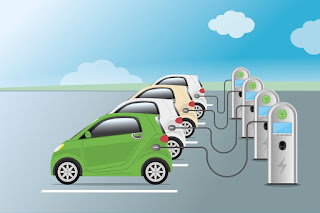Background
Road Electric Vehicles (EVs) include a large range of vehicles from electric two - wheelers, three wheelers E-rickshaws, cars and electric buses.
 In addition, plug - in electric vehicles can be classified into two types: battery electric vehicles (BEVs), and plug - in hybrid electric vehicles (PHEVs). BEVs have an electric motor in place of combustion engine and use electricity from the grid stored in batteries. Plug - in hybrid electric vehicles (PHEV) use batteries to power an electric motor and liquid fuel such as gasoline or diesel to power an internal combustion engine or other propulsion source.
In addition, plug - in electric vehicles can be classified into two types: battery electric vehicles (BEVs), and plug - in hybrid electric vehicles (PHEVs). BEVs have an electric motor in place of combustion engine and use electricity from the grid stored in batteries. Plug - in hybrid electric vehicles (PHEV) use batteries to power an electric motor and liquid fuel such as gasoline or diesel to power an internal combustion engine or other propulsion source.
EVs can go beyond the above mentioned technology based classification, and can be classified on the basis of their attributes such as charging time, driving range, and the maximum load it can carry. Of these attributes, the two most important characteristics of an electric vehicle of concern to the consumer are:
- Driving range (i.e. the maximum distance an EV can run when fully charged)
- Charging time of batteries (i.e. the time required to fully charge the battery) and Charging time depends on the input power characteristics (i.e. input voltage and current), battery type and battery capacity.
Indian EV scenario
National Electric Mobility Mission Plan (NEMMP) 2020
- Target of deploying 5 to 7 million electric vehicles in the country by 2020
- Emphasizes importance of government incentives and coordination between industry and academia
- Target of 400,000 passenger battery electric cars (BEVs) by 2020 ~ avoiding 120 million barrels of oil and 4 million tons of CO2
- Lowering of vehicular emissions by 1.3 percent by 2020
- Total investment required – INR 20,000 – 23,000 cr (approx 3 billion USD)
e-Rikshaw
- The Government of India announced the DeenDayal scheme in June 2014, which would help in the financing and procurement of the battery rickshaws in the country.
- In March 2015 the Motor Vehicles (Amendment) Bill was cleared establishing battery-powered e-rickshaws as a valid form of commercial transport
- 3 wheeled vehicles run by battery power of no more than 4,000 Watts
- 4 passengers, luggage of 50 kg and with a single trip under 25 kilometers
- The number of battery operated e - rickshaws in Delhi has risen from 4,000 in 2010 to more than 1,00,000 in 2014, and is now an integral part of the transport eco-system in the state.
- In January 2014, Tripura became the first state in India to regulate the functioning of the e-rickshaws, and they came up with the Tripura Battery Operated Rickshaw Rules 2014 for the purpose. Tripura Battery Operated Rickshaw Rules 2014 consists norms / guidelines such as driver age limits, license fee, renewal fee, Road Tax, provision for vehicle fitness certificate, insurance for e-rickshaw and identification of routes for operation of these vehicles.
Recommendations
- Adequate capacity addition primarily through Renewables in distribution grid in order to meet additional demand created by high penetration of EVs.
- EV charging station to be designed preferably with rooftop solar generation to minimize dependence on fossil fuels in entire supply chain hence shifting towards clean energy.
- Encourage EV manufacturers to design vehicles with changeable batteries, so that EV owner can just move in the charging station, replace his battery with fully charged battery and move on. The charging station can plan to charge the batteries during off peak time at reduced electricity tariff or direct from roof top solar power.
- Use of dynamic pricing model and smart grid tools for charging stations to encourage charging at non - peak timings hence aiding to Peak Load Management.
- Area wise integrated planning of public transport, EV promotion and Renewable Generation with dynamic pricing of electricity and Smart Grid tools for monitoring and control.
- Adoption of EV standards Charging connector standards are being developed by Automotive Research Association of India. Rating of charging sockets: Does household 16A sockets are good enough for household EV charging? Or does it need industry standard sockets?
- Utility to sanction installation of charging point at homes for EV charging based on available capacity of distribution grid in that area.
- Identification of EV charging nodes in the existing distribution network without affecting the voltage profile of the network.
- Suitable pricing mechanism to be developed, in case Utility needs to augment the distribution grid to support EV charging.
- Intelligent Charging Stations equipped with Fast chargers, timers and capable of switching to normal charging mode based on real time grid conditions/parameters.
- Battery disposal /recycling norms as per ( Batteries (Management and Handling) Rules, 2001 ) published by Ministry of Environment, Forest and Climate Change need to be strictly enforced so as to prevent adverse environmental impacts of battery.
- Investment in R&D for future battery technologies resulting in batteries with much higher specific energy, environment friendly and lower costs. As batteries constitutes 50% cost of EV’s.
- Other initiatives that may help scale up EV in cities include local plans for electric vehicles, subsidies, dedicated parking and related incentives, use of information technology (IT) to locate charging stations, collaboration with private companies, as well as public car share and lease.






0 Comments